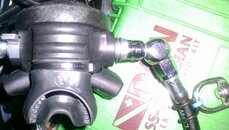My regs are set up with a 90° angle on the primary second stage (hose routed under the arm) and a 110° on my bungeed octo. My LDS guy says divers he knows find that they get less airflow with angle adapters because when the gas is pushed through a tight corner it creates a de facto restriction.
Has anyone found this to be true? Have there been any objective tests that might confirm or debunk this?
Has anyone found this to be true? Have there been any objective tests that might confirm or debunk this?
Last edited:




